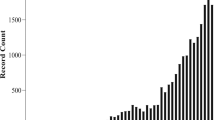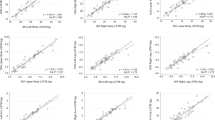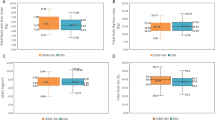Abstract
This review is directed to define the efficacy of bioelectrical impedance vector analysis (BIVA) for assessing two-compartment body composition. A systematic literature review using MEDLINE database up to 12 February 2014 was performed. The list of papers citing the first description of BIVA, obtained from SCOPUS, and the reference lists of included studies were also searched. Selection criteria included studies comparing the results of BIVA with those of other techniques, and studies analyzing bioelectrical vectors of obese, athletic, cachectic and lean individuals. Thirty articles met the inclusion criteria. The ability of classic BIVA for assessing two-compartment body composition has been mainly evaluated by means of indirect techniques, such as anthropometry and bioelectrical impedance analysis (BIA). Classic BIVA showed a high agreement with body mass index, that can be interpreted in relation to the greater body mass of obese and athletic individuals, whereas the comparison with BIA showed less consistent results, especially in diseased individuals. When a reference method was used, classic BIVA failed to accurately recognize FM% variations, whereas specific BIVA furnished good results. Specific BIVA is a promising alternative to classic BIVA for assessing two-compartment body composition, with potential application in nutritional, sport and geriatric medicine.
This is a preview of subscription content, access via your institution
Access options
Subscribe to this journal
Receive 12 print issues and online access
$259.00 per year
only $21.58 per issue
Buy this article
- Purchase on Springer Link
- Instant access to full article PDF
Prices may be subject to local taxes which are calculated during checkout

Similar content being viewed by others
References
Baumgartner RN . Body composition in healthy aging. Ann N Y Acad Sci 2000; 904: 437–448.
Buffa R, Floris G, Putzu P, Marini E . Body composition variations in ageing. Coll Antropol 2011; 35: 259–265.
Woodrow G . Body composition analysis techniques in the aged adult: indications and limitations. Curr Opin Clin Nutr Metab Care 2009; 12: 8–14.
Morley JE . Protein-energy malnutrition in older subjects. Proc Nutr Soc 1998; 57: 587–592.
Morley JE, Baumgartner RN, Roubenoff R, Mayer J, Nair KS . Sarcopenia. J Lab Clin Med 2001; 137: 231–243.
Fried LP, Tangen CM, Walston J, Newman AB, Hirsch C, Gottdiener J et al. Frailty in older adults: evidence for a phenotype. J Gerontol A Biol Sci Med Sci 2001; 56: M146–M156.
Haslam DW, James WPT . Obesity. Lancet 2005; 366: 1197–1209.
Beydoun MA, Beydoun HA, Wang Y . Obesity and central obesity as risk factors for incident dementia and its subtypes: a systematic review and meta-analysis. Obes Rev 2008; 9: 204–218.
Guigoz Y, Vellas B, Garry PJ . Mini nutritional assessment: a practical assessment tool for grading the nutritional state of elderly patients. Facts Res Geront 1994; 2: 15–59.
National Institutes of Health (NIH). Bioelectrical impedance analysis in body composition measurement: National Institutes of Health Technology Assessment Conference Statement. Am J Clin Nutr 1996; 64: 524S–532S.
Ward LC, Müller MJ . Bioelectrical impedance analysis. Eur J Clin Nutr 2013; 67: S1.
Baumgartner RN, Heymsfield SB, Roche AF . Human body composition and the epidemiology of chronic disease. Obes Res 1995; 3: 73–95.
Piccoli A, Rossi B, Pillon L, Bucciante G . A new method for monitoring body fluid variation by bioimpedance analysis: the RXc graph. Kidney Int 1994; 46: 534–539.
Barbosa-Silva MC, Barros AJ . Bioelectrical impedance analysis in clinical practice: a new perspective on its use beyond body composition equations. Curr Opin Clin Nutr Metab Care 2005; 8: 311–317.
Buffa R, Floris G, Marini E . Bioelectrical impedance vector analysis in the assessment of nutritional status in the elderly. Nutr Ther Metabol 2009; 27: 175–182.
Kyle U, Bosaeus I, De Lorenzo AD, Deurenberg P, Elia M, Manuel Gómez J et al. Bioelectrical impedance analysis-part II: utilization in clinical practice. Clin Nutr 2004; 23: 1430–1453.
Norman K, Stobäus N, Pirlich M, Bosy-Westphal A . Bioelectrical phase angle and impedance vector analysis-clinical relevance and applicability of impedance parameters. Clin Nutr 2012; 31: 854–861.
Buffa R, Saragat B, Cabras S, Rinaldi AC, Marini E . Accuracy of specific BIVA for the assessment of body composition in the United States population. PLoS One 2013; 8: e58533.
Marini E, Sergi G, Succa V, Saragat B, Sarti S, Coin A et al. Efficacy of specific bioelectrical impedance vector analysis (BIVA) for assessing body composition in the elderly. J Nutr Health Aging 2013; 17: 515–521.
Moher D, Liberati A, Tetzlaff J, Altman DG . Preferred reporting items for systematic reviews and meta-analyses: the PRISMA statement. PLoS Med 2009; 6: e1000097.
Barufaldi LA, Conde WL, Schuch I, Duncan BB, Castro TG . Bioelectrical impedance values among indigenous children and adolescents in Rio Grande do Sul, Brazil. Rev Panam Salud Publica 2011; 30: 39–45.
Guida B, Laccetti R, Gerardi C, Trio R, Perrino NR, Strazzullo P et al. Bioelectrical impedance analysis and age-related differences of body composition in the elderly. Nutr Metab Cardiovas Dis 2007; 17: 175–180.
Haas V, Riedl A, Hofmann T, Nischan A, Burghardt R, Boschmann M et al. Bioimpedance and bioimpedance vector analysis in patients with anorexia nervosa. Eur Eat Disord Rev 2012; 40: 400–405.
Kim CH, Park JH, Kim H, Chung S, Park SH . Modeling the human body shape in bioimpedance vector measurements. Conf Proc IEEE Eng Med Biol Soc 2010; 2010: 3872–3874.
Marini E, Maldonado-Contreras AL, Cabras S, Hidalgo G, Buffa R, Marin A et al. Helicobacter pylori and intestinal parasites are not detrimental to the nutritional status of Amerindians. Am J Trop Med Hyg 2007; 76: 534–540.
Marini E, Buffa R, Saragat B, Coin A, Toffanello ED, Berton L et al. The potential of classic and specific bioelectrical impedance vector analysis for the assessment of sarcopenia and sarcopenic obesity. Clin Interv Aging 2012; 7: 585–591.
Micheli ML, Pagani L, Marella M, Gulisano M, Piccoli A, Angelini F et al. Bioimpedance and impedance vector patterns as predictors of male elite soccer players. Int J Sports Physiol Perform 2014, 9: 532–539.
Norman K, Smoliner C, Kilbert A, Valentini L, Lochs H, Pirlich M . Disease-related malnutrition but not underweight by BMI is reflected by disturbed electric tissue properties in the bioelectrical impedance vector analysis. Br J Nutr 2008; 100: 590–595.
Piccoli A, Brunani A, Savia G, Pillon L, Favaro E, Berselli ME et al. Discriminating between body fat and fluid changes in the obese adult using bioimpedance vector analysis. Int J Obes Relat Metab Disord 1998; 22: 97–104.
Scalfi L, Marra M, Caldara A, Silvestri E, Contaldo F . Changes in Bioimpedance analysis after stable refeeding of undernourished anorexic patients. Int J Obes Relat Metab Disord 1999; 23, 133–137.
Guida B, Pietrobelli A, Trio R, Laccetti R, Falconi C, Perrino NR et al. Body mass index and bioelectrical vector distribution in 8-year-old children. Nutr Metab Cardiovasc Dis 2008; 18: 133–141.
Savastano S, Di Somma C, Belfiore A, Guida B, Orio JF, Rota F et al. Growth hormone status in morbidly obese subjects and correlation with body composition. J Endocrinol Invest 2006; 29: 536–543.
Savastano S, Belfiore A, Di Somma C, Mauriello C, Rossi A, Pizza G et al. Validity of bioelectrical impedance analysis to estimate body composition changes after bariatric surgery in premenopausal morbidly women. Obes Surg 2010; 20: 332–339.
Buffa R, Saragat B, Succa V, Ruggiu R, Carboni L, Putzu PF et al. Elderly subjects with type 2 diabetes show altered tissue electrical properties. Nutrition 2013; 29: 132–137.
Gatterer H, Schenk K, Ferrari P, Faulhaber M, Schopp E, Burtscher M . Changes in hydration status of soccer players competing in the 2008 European Championship. J Sports Med Phys Fitness 2011; 51: 89–94.
Nescolarde L, Yanguas J, Medina D, Rodas G, Rosell-Ferrer J . Assessment and follow-up of muscle injuries in athletes by bioimpedance: preliminary results. Conf Proc IEEE Eng Med Biol Soc 2011; 2011: 1137–1140.
Piccoli A, Piazza P, Noventa D, Pillon L, Zaccaria M . A new method for monitoring hydration at high altitude by bioimpedance analysis. Med Sci Sports Exerc 1996; 28: 1517–1522.
Piccoli A, Pastori G, Codognotto M, Paoli A . Equivalence of information from single frequency v. bioimpedance spectroscopy in bodybuilders. Br J Nutr 2007; 97: 182–192.
Castillo-Martínez L, Colín-Ramírez E, Orea-Tejeda A, González Islas DG, Rodríguez García WD, Santillán Díaz C et al. Cachexia assessed by bioimpedance vector analysis as a prognostic indicator in chronic stable heart failure patients. Nutrition 2012; 28: 866–891.
Norman K, Pirlich M, Sorensen J, Christensen P, Kemps M, Schütz T et al. Bioimpedance vector analysis as a measure of muscle function. Clin Nutr 2009; 28: 78–82.
Colín-Ramirez E, Orea-Tejada A, Castillo-Martínez L, Montaño-Hernández P, Sánchez-Ramírez A, Pineda-Juárez JA et al. Malnutrition syndrome, but not body mass index, is associated to worse prognosis in heart failure patients. Clin Nutr 2011; 30: 753–758.
Buffa R, Floris G, Marini E . Migration of the bioelectrical impedance vector in healthy elderly subjects. Nutrition 2003; 19: 917–921.
Piccoli A, Codognotto M, Di Pascoli L, Boffo G, Caregaro L . Body mass index and agreement between bioimpedance and anthropometry estimates of body compartments in anorexia nervosa. JPEN J Parenter Enteral Nutr 2005; 29: 148–156.
Saragat B, Buffa R, Mereu E, Succa V, Cabras S, Mereu RM et al. Nutritional and psycho-functional status in elderly patients with Alzheimer's disease. J Nutr Health Aging 2012; 16: 231–236.
Baldwin CE, Paratz JD, Bersten AD . Body composition analysis in critically Ill survivors: a comparison of bioelectrical impedance spectroscopy devices. JPEN J Parenter Enteral Nutr. 2012; 36: 306–5.
Bronhara B, Piccoli A, Pereira JC . Fuzzy linguistic model for bioelectrical impedance vector analysis. Clin Nutr 2012; 31: 710–716.
Siervo M, Faber P, Gibney ER, Lobley GE, Elia M, Stubbs RJ et al. Use of the cellular model of body composition to describe changes in body water compartments after total fasting, very low calorie diet and low calorie diet in obese men. Int J Obes 2010; 34: 908–918.
Dittmar M, Reber H . New equations for estimating body cell mass from bioimpedance parallel models in healthy older Germans. Am J Physiol Endocrinol Metab 2011; 281: 1005–1014.
Saragat B, Buffa R, Mereu E, De Rui M, Coin A, Sergi G et al. Specific bioelectrical impedance vector reference values for assessing body composition in the Italian elderly. Exp Gerontol 2014; 50: 52–56.
World Health Organization (WHO). Obesity: preventing and managing the global epidemic. Report of a WHO consultation. World Health Organ Tech Rep Ser 2000; 894:i-xii, 1–253.
Acknowledgements
EM acknowledges financial support from the University of Cagliari and from ‘Regione Autonoma della Sardegna’ through a research grant on fundings of the Project PO Sardegna FSE 2007–2013, L.R.7/2007 Promozione della ricerca scientifica e dell’innovazione tecnologica in Sardegna. The funders had no role in study design, data collection and analysis, decision to publish or preparation of the manuscript.
Author information
Authors and Affiliations
Corresponding author
Ethics declarations
Competing interests
The authors declare no conflict of interest.
Rights and permissions
About this article
Cite this article
Buffa, R., Mereu, E., Comandini, O. et al. Bioelectrical impedance vector analysis (BIVA) for the assessment of two-compartment body composition. Eur J Clin Nutr 68, 1234–1240 (2014). https://doi.org/10.1038/ejcn.2014.170
Received:
Accepted:
Published:
Issue Date:
DOI: https://doi.org/10.1038/ejcn.2014.170
This article is cited by
-
Capillary leak and endothelial permeability in critically ill patients: a current overview
Intensive Care Medicine Experimental (2023)
-
Physical activity and/or dietary intervention in overweight or obese breast cancer survivors: results of the InForma randomized trial
Journal of Cancer Survivorship (2023)
-
Epidemiological, mechanistic, and practical bases for assessment of cardiorespiratory fitness and muscle status in adults in healthcare settings
European Journal of Applied Physiology (2023)
-
Phase angle and diabetes in community-dwelling older adults: cross-sectional analysis from the Malaysian elders longitudinal research (MELoR) study
European Journal of Clinical Nutrition (2022)
-
Association between classic and specific bioimpedance vector analysis and sarcopenia in older adults: a cross-sectional study
BMC Sports Science, Medicine and Rehabilitation (2022)



